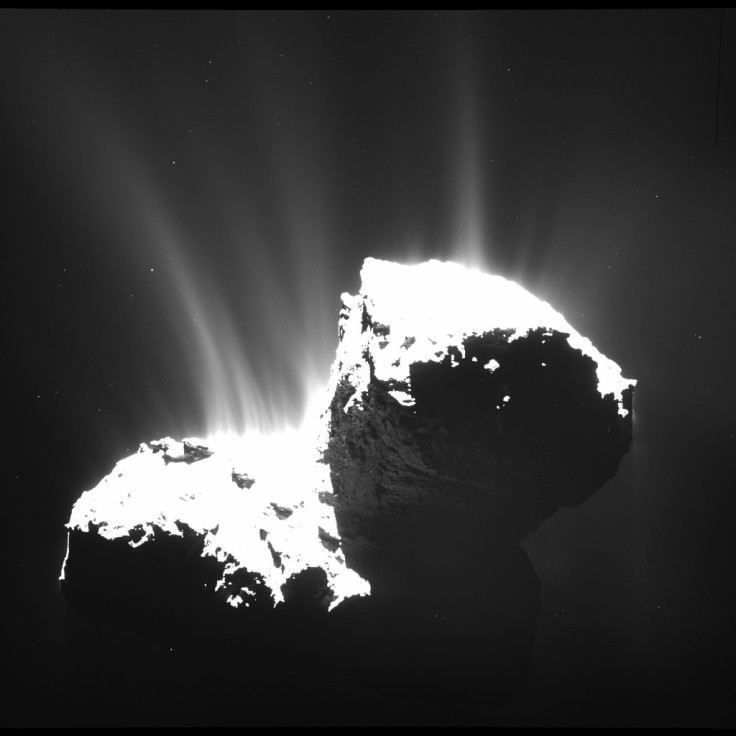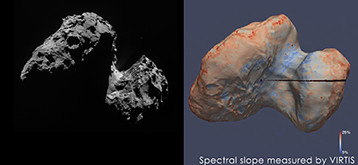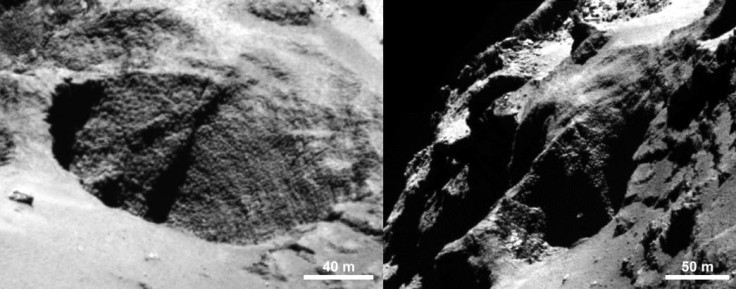Rosetta data details the frozen world of a comet for the first time


An unusual two-lobed shape, high porosity on its surface, organic materials in its nucleus and hectic activity around its "neck" are some of the mysteries of comet 67P/Churyumov-Gerasimenko that the Rosetta mission has unveiled.
In seven papers published on 23 January, 2015 in Science, scientists have explained the significance of their findings.
The wide range of the surface features and organic content have been revealed after analysing data obtained from the MIRO, VIRTIS, GIADA and OSIRIS instruments of ESA's Rosetta mission.
The surface of comet 67P/Churyumov-Gerasimenko (nicknamed Churi), is homogeneous and displays a variety of surface structures caused by erosion, collapse and redeposition processes.
A series of images from OSIRIS camera combined with measurements of mass, have given the first-ever direct determination of the density of a cometary nucleus, showing it is extremely porous.
The MIRO instrument helped draw up a map of the near subsurface of 67P showing seasonal and diurnal variations in temperature that point to low thermal conductivity of the surface.
Spectroscopic measurements by VIRTIS of various materials in the comet's nucleus show carbon-hydrogen and/or oxygen-hydrogen bonds associated with dark, opaque minerals such as iron sulfides (pyrrhotite and troilite).
Ice-rich patches exceeding 20 metres implies that the top few centimetres of the surface are highly dehydrated.
Cometary magnetosphere
In a first, the making of a cometary magnetosphere was caught by the RPC-ICA (Ion Composition Analyser) instrument in the first detection of water ions to the moment when the cometary atmosphere began to repel the solar wind, indicating the formation of Churi's magnetosphere.
As the comet approaches the sun, it gets warmer and volatile substances, mainly water, evaporate from the surface, forming an atmosphere around the comet. The Sun's ultraviolet radiation and collisions with the solar wind ionizes some of the comet's atmosphere. These ions can then be accelerated to high speeds by the solar wind electric and magnetic fields.
As the comet gets close to the Sun, its atmosphere becomes so dense and ionised that it becomes electrically conductive. When this happens, the atmosphere begins to resist the solar wind and the comet's magnetosphere is born.
Rosetta's RPC-ICA instrument detected low velocity water ions in data collected on 7 August, 2014, a day after arriving at Comet 67P/C-G at a distance of 100 km.
"It was an unambiguous signature of the comet, a clear detection of ions from the comet's atmosphere," says associate professor Hans Nilsson at the Swedish Institute of Space Physics (IRF) in Kiruna.
Formed around 4.5 billion years ago and frozen ever since, comets preserve traces of the original primordial solar system matter. Studying their nucleus and coma gives clues about the conditions in the early Solar System.
The Rosetta ROSINA instrument measured the composition of 67P's coma (relatively dense atmosphere surrounding the nucleus, made up of a mixture of dust and gas molecules) by monitoring the comet's rotation.
Gas variations
Researchers in Bern have detected considerable variations in the gas escaping from the comet's coma or atmosphere. This could amount to seasonal changes on the comet.
Peaks in the water density and carbon dioxide measurements could point towards a day-night or seasonal summer-winter effect.
Or, the comet's nucleus could be inhomogeneous suggesting its material originated from different regions of the early solar system.
Bern scientists are also analysing the diverse surface of the comet as seen in the Osiris images, showing a hard surface in places and a crumbling one elsewhere.
Launched in March 2004, Rosetta visited Mars, came back to Earth (briefly being misidentified by astronomers as an asteroid), then visited asteroid 2867 Šteins 5, then back to Earth again, next dropped in on asteroid 21 Lutetia, before finally reaching 67P in August last year.
Rosetta will continue to study the comet from orbit over the course of a year, leading to the comet's closest point of approach to the Sun in June. It will remain in orbit around 67P much after its lifetime, tied to the comet by its weak gravitational tug.

© Copyright IBTimes 2025. All rights reserved.





















